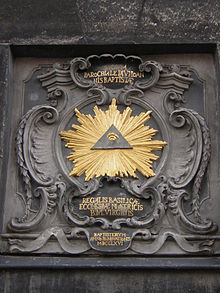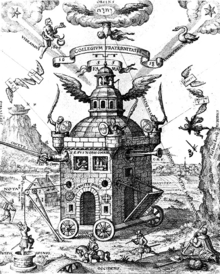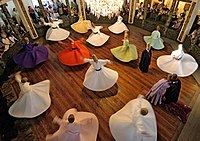
The goddess Persephone, from the great Eleusinian relief in the National Archaeological Museum in Athens
Mysticism (
 pronunciation (help·info)
pronunciation (help·info); from the
Greek μυστικός,
mystikos, meaning 'an initiate') is the knowledge of, and especially the personal experience of,
states of consciousness, or
levels of being, or aspects of reality, beyond normal human perception, sometimes including experience of and even communion with a
supreme being.
[edit] Classical origins
A "mystikos" was an initiate of a
mystery religion. The
Eleusinian Mysteries, (Greek:
Ἐλευσίνια Μυστήρια) were annual initiation ceremonies in the cults of the goddesses
Demeter and
Persephone, held in secret at Eleusis (near
Athens) in
ancient Greece.
[1] The mysteries began in about 1600 B.C. in the
Mycenean period and continued for two thousand years, becoming a major festival during the
Hellenic era, and later spreading to Rome.
[2]
[edit] Modern understanding
The present meaning of the term
mysticism arose via
Platonism and
Neoplatonism—which referred to the Eleusinian initiation as a
metaphor for the "initiation" to spiritual truths and experiences—and is the pursuit of
communion with, identity with, or
conscious awareness of an
ultimate reality,
divinity,
spiritual truth, or
God through direct experience, intuition, instinct or insight. Mysticism usually centers on practices intended to nurture those
experiences. Mysticism may be
dualistic, maintaining a distinction between
the self and the divine, or may be
nondualistic.
[3]
Many if not all of the world's great religions have arisen around the teachings of mystics (including Buddha, Jesus, Lao Tze, and Krishna); and most religious traditions describe fundamental mystical experience, at least esoterically.
Enlightenment or
Illumination are generic English terms for the phenomenon, derived from the Latin
illuminatio (applied to Christian
prayer in the 15th century) and adopted in English translations of
Buddhist texts, but used loosely to describe the state of mystical attainment regardless of faith.
[4]
Conventional
religions, by definition, have strong institutional structures, including formal
hierarchies and mandated
sacred texts and/or
creeds. Adherents of the faith are expected to respect or follow these closely, so mysticism is often deprecated or persecuted.
[5]
The following table briefly summarizes the major forms of mysticism within world religions and their basic concepts.
Mysticism in World Religions
| Host Religion | Form of Mysticism | Basic Concept | Sources of Information |
|---|
| Buddhism | Shingon, Vajrayana, Zen | attainment of Nirvana, Satori, Bodhi, union with Mahamudra or Dzogchen | [6][7] |
| Christianity | Catholic spirituality, Quaker tradition, Christian mysticism, Gnosticism | Spiritual enlightenment, Spiritual vision, the Love of God, union with God (Theosis) | [8][9][10] |
| Freemasonry | - | Enlightenment | [11] |
| Hinduism | Vedanta, Yoga, Bhakti, Kashmir Shaivism | liberation from cycles of Karma (moksha), self-realization (atma-jnana), non-identification (Kaivalya), experience of ultimate reality (Samadhi), Innate Knowledge (Sahaja and Svabhava) | [12][13] |
| Islam | Sunni, Shia, Sufism | Innate belief in god (Fitra); Fana (Sufism); Baqaa. | [14] |
| Jainism | Moksha | liberation from cycles of Karma | [15] |
| Judaism | Kabbalah, Hasidism | abnegation of the ego, Ein Sof | [16] |
| Rosicrucianism | - | - | [17] |
| Sikhism | - | liberation from cycles of Karma | [18][19][20] |
| Taoism | - | Te: connection to ultimate reality | [21] |
[edit] Literary forms used by spiritual teachers
Since, by definition, mystical knowledge cannot be directly written down or spoken of (but must be experienced), numerous literary forms that allude to such knowledge - often with contradictions or even jokes - have developed, for example:
[edit] Aphorisms, poetry
Aphorisms and poetry include artistic efforts to crystallize some particular description or aspect of the
mystical experience in words:
-
[edit] Koans, riddles, contradictions
Zen
koans, riddles, and metaphysical contradictions are intentionally irresolvable tasks or lines of thought, designed to direct one away from intellectualism and effort towards direct experience.
[23]
-
These can be meant as humorous phrases (see humour, below); or as serious questions with significant mystical answers. Others believe that the most edifying understanding of these riddles is that excessive effort contemplating the impossible can give an individual the opportunity to stop trying to 'achieve' and start just 'being'.
- The evocative Taoist phrase—To yield is to be preserved whole, to be bent is to become straight, to be empty is to be full, to have little is to possess[24] —is another example of a metaphysical contradiction describing the path of emptying the learned self.
Jokes and humorous stories can be used in spiritual teaching to make simple yet profound metaphysical points:
- Some examples are the Nasreddin tales,[25] e.g. someone shouts at Nasreddin sitting on a river bank, "How do I get across?" "You are across." he replies;
-
- the Trickster or Animal Spirit stories passed down in Native American, Australian Aboriginal, and African Tribal folklore, and even the familiar "Br'er Rabbit and the Tar Baby".[27]
[edit] Stories, parables, metaphors
Parables and
metaphor include stories that have a deeper meaning to them:
- Jesus makes use of parables and metaphors when teaching his followers. See Parables of Jesus.
Some Passages seem to be aphorisms, riddles and parables all at once. For instance,
Yunus Emre's famous passage:
- I climbed into the plum tree
- and ate the grapes I found there.
- The owner of the garden called to me,
- "Why are you eating my walnuts?"
[edit] Induction of mystical experiences
Various religious texts prescribe meditative practices in order to achieve the state of consciousness which is typical of religious experience. Texts of
Yoga and
Tantra mention specific physical, nutritive, ethical, and meditative methods in order to achieve specific kinds of experiences.
[citation needed] The traditions of Mantra Marga (literally, "the way of formulae") in particular stress the importance of saying, either aloud or to oneself internally, particular
Mantras (phrases to be repeated) given by their teacher.
[28] Combined with this is the set of practices related to
Yantras (symbols to be meditated on). Various other ways not specific of any religion include:
[edit] A perennial philosophy
The centuries-old idea of a
perennial philosophy, popularized by
Aldous Huxley in his 1945 book:
The Perennial Philosophy, states one view of what mysticism is all about:
[W]ith the one, divine reality substantial to the manifold world of things and lives and minds. But the nature of this one reality is such that it cannot be directly or immediately apprehended except by those who have chosen to fulfill certain conditions, making themselves loving, pure in heart, and poor in spirit.[45]
[edit] Natural and religious mysticism
R. C. Zaehner has identified two distinctively different mystical experiences: natural and religious mystical experiences, this being the overarching thesis of his book
Mysticism Sacred and Profane.
[46] Natural mystical experiences are, for example, experiences of the 'deeper self' or experiences of oneness with nature. Zaehner argues that the experiences typical of 'natural mysticism' are quite different from the experiences typical of religious mysticism. In this, Zaehner is directly opposing the views
Aldous Huxley put forward in
The Perennial Philosophy according to which the mystical experiences in all religions are essentially the same. Natural mystical experiences are in Zaehner's view of less value because they do not lead as directly to the virtues of charity and compassion. Zaehner is generally critical of what he sees as narcissistic tendencies in nature mysticism.
[47]
[edit] The unknowable
According to
Schopenhauer,
[48] mystics arrive at a condition in which there is no knowing subject and known object:
... we see all religions at their highest point end in mysticism and mysteries, that is to say, in darkness and veiled obscurity. These really indicate merely a blank spot for knowledge, the point where all knowledge necessarily ceases. Hence for thought this can be expressed only by negations, but for sense-perception it is indicated by symbolical signs, in temples by dim light and silence, in Brahmanism even by the required suspension of all thought and perception for the purpose of entering into the deepest communion with one's own self, by mentally uttering the mysterious Om. In the widest sense, mysticism is every guidance to the immediate awareness of what is not reached by either perception or conception, or generally by any knowledge. The mystic is opposed to the philosopher by the fact that he begins from within, whereas the philosopher begins from without. The mystic starts from his inner, positive, individual experience, in which he finds himself as the eternal and only being, and so on. But nothing of this is communicable except the assertions that we have to accept on his word; consequently he is unable to convince.
[edit] Skepticism
In
The Emotion Machine,
Marvin Minsky[49] argues that mystical experiences only
seem profound and persuasive because the mind's critical faculties are relatively inactive during them:-
'Meditator: It suddenly seemed as if I was surrounded by an immensely powerful Presence. I felt that a Truth had been "revealed" to me that was far more important than anything else, and for which I needed no further evidence. But when later I tried to describe this to my friends, I found that I had nothing to say except how wonderful that experience was.This peculiar type of mental state is sometimes called a "Mystical Experience" or "Rapture," "Ecstasy," or "Bliss." Some who undergo it call it "wonderful," but a better word might be "wonderless," because I suspect that such a state of mind may result from turning so many Critics off that one cannot find any flaws in it.
What might that "powerful Presence" represent? It is sometimes seen as a deity, but I suspect that it is likely to be a version of some early Imprimer that for years has been hiding inside your mind. In any case, such experiences can be dangerous—for some victims find them so compelling that they devote the rest of their lives to trying to get themselves back to that state again.'
[edit] See also
[edit] References and footnotes
- ^ Kerényi, Karoly, "Kore," in C.G. Jung and C. Kerényi, Essays on a Science of Mythology: The Myth of the Divine Child and the Mysteries of Eleusis. Princeton: Princeton University Press, 1963: pages 101-55.
- ^ Eliade, Mircea, A History of Religious Ideas: From the Stone Age to the Eleusinian Mysteries. Chicago: University of Chicago Press, 1978.
- ^ W.F. Cobb. Mysticism and the Creed. BiblioBazaar, 2009. ISBN 978-1-113-20937-5
- ^ Evelyn Underhill. Practical Mysticism. Wilder Publications, new edition 2008. ISBN 978-1-60459-508-6
- ^ David Steindl-Rast. The Mystical Core of Organized Religion. ReVision, Summer 1989. 12 (1):11-14. Council on Spiritual Practices Retrieved 29 October 2011
- ^ D.T. Suzuki. Mysticism: Christian and Buddhist. Routledge, 2002. ISBN 978-0-415-28586-5
- ^ Shunryu Suzuki. Zen Mind, Beginner's Mind. Shambhala. New edition 2011.
- ^ Louth, Andrew., The Origins of the Christian Mystical Tradition. Oxford: Oxford University Press, 2007. ISBN 978-0-19-929140-3.
- ^ King, Ursula. Christian Mystics: Their Lives and Legacies Throughout the Ages. London: Routledge 2004.
- ^ Fanning, Steven., Mystics of the Christian Tradition. New York: Routledge Press, 2001.
- ^ Michael R. Poll. Masonic Enlightenment - The Philosophy, History And Wisdom Of Freemasonry. Michael Poll Publishing, 2006.
- ^ S. N. Dasgupta. Hindu Mysticism. BiblioBazaar, 2009. ISBN 978-0-559-06989-5
- ^ a b K.A. Jacobson. Theory and Practice of Yoga, 2005. Page 10 and throughout.
- ^ Reynold A. Nicholson. Studies in Islamic Mysticism. Routledge. New edition 2001. ISBN 978-0-7007-0278-7
- ^ T.K. Tukol. Yoga, Meditation & Mysticism in Jainism (Shri Raj Krishen Jain memorial lectures). Shri Raj Krishen Jain Charitable Trust, 1978.
- ^ Elior, Rachel, Jewish Mysticism: The Infinite Expression of Freedom, Oxford. Portland, Oregon: The Littman Library of Jewish Civilization, 2007.
- ^ A.E. Waite. Rosicrucian Rites and Ceremonies of the Fellowship of the Rosy Cross by Founder of the Holy Order of the Golden Dawn. Ishtar, 2008. ISBN 978-0-9783883-4-8
- ^ Mohan Singh Uberoi. Sikh Mysticism. 1964.
- ^ Krishna Chattopadhyay. The world of mystics: A comparative study of Baul, Sufi and Sikh mysticism. R.K. Prakashan, 1993.
- ^ "Sikh Beliefs". God and the cycle of life. BBC. 24 September 2009. http://www.bbc.co.uk/religion/religions/sikhism/beliefs/beliefs.shtml. Retrieved 24 July 2012.
- ^ Harold D Roth. Original Tao: Inward Training (Nei-yeh) and the Foundations of Taoist Mysticism. Columbia University Press. New Edition, 2004. ISBN 978-0-231-11565-0
- ^ Jalaluddin Rumi: Poems
- ^ Koun Yamada. The Gateless Gate: The Classic Book of Zen Koans. Wisdom Publications. New edition, 2005. ISBN 978-0-86171-382-0
- ^ Tao Te Ching. LinYutan version. Chapter 22, sentence 1. For other versions see TTC Compared
- ^ Nasruddin stories
- ^ *Bektashi jokes
- ^ Brer Rabbit and the Tar Baby retold by S.E. Schlosser as 'A Georgia Folktale'. Retrieved 29 October 2011.
- ^ Daniélou, Alain: Yoga, methods of re-integration
- ^ "'Divining the brain" Salon.com (URL accessed on September 20, 2006)
- ^ "'Exploring the biology of religious experience" NRC online
- ^ "'The Emotional Effects of Music on Religious Experience: A Study of the Pentecostal-Charismatic Style of Music and Worship " Sage Journals
- ^ "Sufis seek ultimate religious experience through mystic trances or altered states of consciousness, often induced through twirling dances " Sufism: New Age Spirituality Dictionary
- ^ "'Self-inflicted Pain in Religious Experience " www.faithfaq.com (URL accessed on July 11, 2006)
- ^ *Deida, David. Finding God Through Sex ISBN 1-59179-273-8
- ^ "'Psychedelics and Religious Experience " Alan Watts http://deoxy.org/ (URL accessed on July 11, 2006)
- ^ "'Those who think of the salvia experience in religious, spiritual, or mystical terms may speak of such things as enlightenment, satori, and "cleansing the doors of perception." " sagewisdom.org (URL accessed on August 26, 2007)
- ^ "'A Note on the Safety of Peyote when Used Religiously. " www.csp.org Council on Spiritual Practices (URL accessed on July 11, 2006)
- ^ "'Drug's Mystical Properties Confirmed " www.washingtonpost.com (URL accessed on July 11, 2006)
- ^ "'The Psychology of Religion: An Empirical Approach. " Conuncil on Spiritual Practices (URL accessed on July 11, 2006)
- ^ "'Resurrection of the Higher Self " www.erowid.org (URL accessed on July 22, 2012)
- ^ Katie, Byron. Loving What Is page xi ISBN 1-4000-4537-1
- ^ "'God on the Brain " http://news.bbc.co.uk (URL accessed on March 20, 2003)
- ^ "My Stroke of Insight" http://www.ted.com/index.php/talks/jill_bolte_taylor_s_powerful_stroke_of_insight.html (URL accessed on July 2, 2008)
- ^ Moody, Raymond. Life After Life ISBN 0-06-251739-2
- ^ Huxley, Aldous (1945). The Perennial Philosophy. Perennial. ISBN 0-06-057058-X.
- ^ Zaehner, R. C. Mysticism Sacred and Profane, Oxford University Press
- ^ See especially Chapters 3,4, and 6
- ^ Schopenhauer, Arthur (1844). Die Welt als Wille und Vorstellung. 2.
- ^ Minksy, M: The Emotion Machine, Chapter 3, Being in Pain
[edit] Further reading
- Baba, Meher (1995). Discourses. Myrtle Beach, S.C.: Sheriar Foundation. http://www.discoursesbymeherbaba.org.
- Daniels, P., Horan A. Mystic Places. Alexandria, Time-Life Books, 1987.
- Dinzelbacher, Peter. Mystik und Natur. Zur Geschichte ihres Verhältnisses vom Altertum bis zur Gegenwart. (Theophrastus Paracelsus Studien, 1) Berlin, 2009.
- Elior, Rachel, Jewish Mysticism: The Infinite Expression of Freedom, Oxford. Portland, Oregon: The Littman Library of Jewish Civilization, 2007.
- Fanning, Steven., Mystics of the Christian Tradition. New York: Routledge Press, 2001.
- Jacobsen, Knut A. (Editor); Larson, Gerald James (Editor) (2005). Theory And Practice of Yoga: Essays in Honour of Gerald James Larson. Brill Academic Publishers. (Studies in the History of Religions, 110 | url = http://books.google.com/books?id=TDGFFNYvrokC)
- Harmless, William, Mystics. Oxford, 2008.
- King, Ursula. Christian Mystics: Their Lives and Legacies Throughout the Ages. London: Routledge 2004.
- Kroll, Jerome, Bernard Bachrach. The Mystic Mind: The Psychology of Medieval Mystics and Ascetics. New York and London: Routledge, 2005.
- Langer, Otto. Christliche Mystik im Mittelalter. Mystik und Rationalisierung – Stationen eines Konflikts. Darmstadt, 2004.
- Louth, Andrew., The Origins of the Christian Mystical Tradition. Oxford: Oxford University Press, 2007.
- Masson, Jeffrey and Terri C. Masson. Buried Memories on the Acropolis. Freud's Relation to Mysticism and Anti-Semitism. International Journal of Psycho-Analysis, Volume 59, 1978, pages 199-208.
- McKnight, C.J. Mysticism, the Experience of the Divine: Medieval Wisdom. Chronicle Books, 2004.
- McGinn, Bernard, The Presence of God: A History of Western Christian Mysticism'.' Volumes 1 - 4. (The Foundations of Mysticism; The Growth of Mysticism; The Flowering of Mysticism) New York, Crossroad, 1997-2005.
- Merton, Thomas, An Introduction to Christian Mysticism: Initiation into the Monastic Tradition, 3. Kalamazoo, 2008.
- Nelstrop, Louise, Kevin Magill and Bradley B. Onishi, Christian Mysticism: An Introduction to Contemporary Theoretical Approaches. Aldershot, 2009.
- Otto, Rudolf (author); Bracy, Bertha L. (translator) & Payne, Richenda C. 1932, 1960. Mysticism East and West: A Comparative Analysis of the Nature of Mysticism. New York, N. Y., USA: The Macmillan Company
- Stace, W. T. Mysticism and Philosophy. 1960.
- Stace, W. T. The Teachings of the Mystics, 1960.
- Underhill, Evelyn. Mysticism: A Study in the Nature and Development of Spiritual Consciousness. 1911
[edit] External links







No comments:
Post a Comment